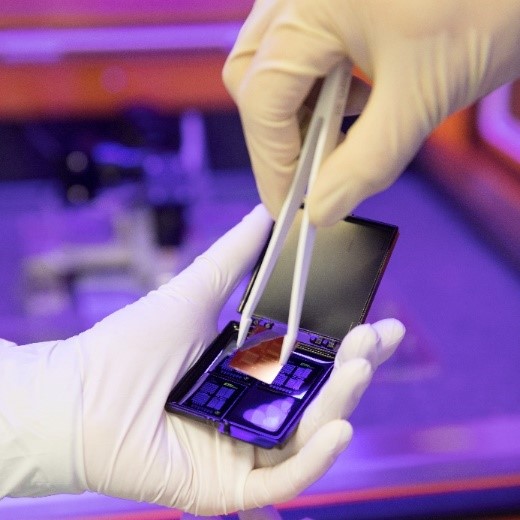New modulator for less energy consumption
To bring down the energy consumption of today’s communication infrastructure, researchers from the Institute of Electromagnetic Fields developed a new component that efficiently transforms electrical data into optical light signals consuming extremely little energy. This new technology, described in a paper recently published in Nature Communications, can be used to transfer ever-growing amounts of information between cities, datacenters and even continents.
Power for energy-hungry applications and technologies
Emerging applications, such as telemedicine, augmented reality, and supercomputing are reshaping our society. Supercomputers enable complex simulations and data analysis (e.g. in meteorology, pharmacology and biology), helping society to better understand climate change or to find a cure for diseases. Telemedicine and augmented reality applications on the other hand allow human interaction anywhere on the globe at any time, while not requiring travelling and therefore saving not only time and money, but also dramatically reducing CO2 emissions.
All these technologies are, however, extremely data-hungry and require a powerful communication infrastructure that can handle these data. Currently, we rely on an infrastructure that transports unprecedented amounts of data on a daily basis. Yet, the data transport is expected to grow by another factor 10 to 100 in the next few years in order to enable these new applications. This is challenging as the current infrastructure already consumes considerable energy resources and faces speed limits. In order to further grow the data infrastructure while keeping the energy consumption moderate, new technologies are urgently needed.
Electro-optical modulators as a solution

Electro-optic modulators are key to this infrastructure. They are devices that can transform electrical data from the computers and servers to optical signals that are then transported in optical fibers. These modulators need to become not only faster, but also more compact and energy-efficient. If many of these electro-optic modulators could be densely integrated on a single microchip, the transformation from electrical data to optical signals would meet the needs of the future communication infrastructure. Eventually, reducing electrical energy consumption is essential to further minimize the CO2 footprint of our society.
Research collaboration between Switzerland and the United States
Researchers at the Institute of Electromagnetic Fields at ETH Zurich, headed by Prof. Juerg Leuthold, in collaboration with colleagues at the University of Washington, USA, developed a new electro-optic modulator that helps in reducing the energy consumption of the network while at the same time providing new routes to densely integrate high-speed electro-optic components. These so-called "plasmonic IQ modulators" were fabricated on a silicon photonic platform that is expected to become the standard technology for integrated optics. “The new modulators require 100 times less space on the silicon chip than conventional silicon-photonic modulators”, explains Wolfgang Heni, the lead author of the paper. “They further require about an order of magnitude lower driving voltages than competing high-speed modulators. Lastly, the new generation of modulators work at a speed that is unmatched by other technologies.”
“The new modulators require 100-times less space on the silicon chip than conventional silicon-photonic modulators.”Wolfgang Heni, doctoral student and lead author of the paper
The plasmonic IQ modulators rely on so-called “plasmonic phase shifters” that occupy as little as 300 µm2. This is in contrast to conventional modulators that take over 100 times more space. The devices are operated with sub-1V driving electronics enabling low electrical energy consumptions of only 0.07 fJ/bit at 50 Gbit/s, 0.3 fJ/bit at 200 Gbit/s, and 2 fJ/bit at 400 Gbit/s.
The breakthrough was recently reported by Wolfgang Heni, Yuriy Fedoryshyn, Benedikt Baeuerle, Arne Josten, Claudia Hössbacher, Andreas Messner, Christian Haffner, Tatsuhiko Watanabe, Yannick Salamin, Ueli Koch, Delwin Elder, Larry Dalton and Juerg Leuthold in Nature Communications in an article entitled “Plasmonic IQ modulators with attojoule per bit electrical energy consumption”.